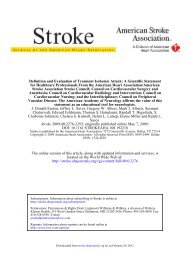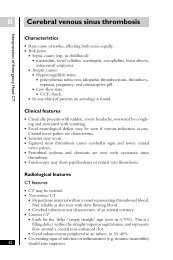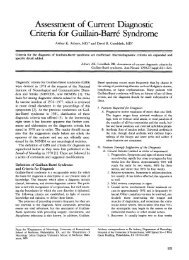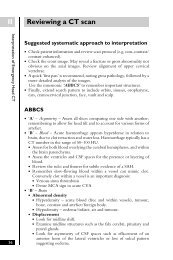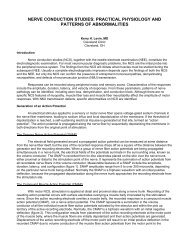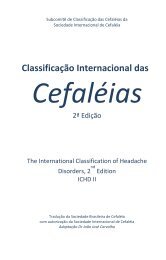nerve conduction studies: essentials and pitfalls in practice
nerve conduction studies: essentials and pitfalls in practice
nerve conduction studies: essentials and pitfalls in practice
- No tags were found...
You also want an ePaper? Increase the reach of your titles
YUMPU automatically turns print PDFs into web optimized ePapers that Google loves.
Downloaded from jnnp.bmj.com on June 5, 2012 - Published by group.bmj.comNEUROLOGY IN PRACTICEii24Box 1: List of abbreviations <strong>and</strong> term<strong>in</strong>ologyusedcccccccccccccccccccccACh: acetylchol<strong>in</strong>eAIDP: acute <strong>in</strong>flammatory demyel<strong>in</strong>at<strong>in</strong>g polyneuropathyAMAN: acute motor axonal neuropathyCMAP: compound muscle action potentialCN: cl<strong>in</strong>ical neurophysiologistDRG: dorsal root ganglionEMG: electromyogramLEMS: Lambert-Eaton myasthenic syndromeMG: myasthenia gravisNAP: <strong>nerve</strong> action potentialNCS: <strong>nerve</strong> <strong>conduction</strong> <strong>studies</strong>NMTD: neuromuscular transmission disordersPNE: peripheral neurophysiological exam<strong>in</strong>ationPNS: peripheral nervous systemRNS: repetitive <strong>nerve</strong> stimulationSNAP: sensory <strong>nerve</strong> action potentialTMS: transcranial magnetic stimulationConduction block: A reduction of proximal CMAP area/amplitude of at least 20% (usually . 50%) compared withdistal CMAP area/amplitude. The duration of theproximal CMAP should not <strong>in</strong>crease by . 20% (seetemporal dispersion)Temporal dispersion: A reduction <strong>in</strong> proximal CMAPamplitude compared with distal CMAP amplitude whenthe proximal CMAP duration <strong>in</strong>creases by . 20%Orthodromic: Nerve action potentials carried <strong>in</strong> thephysiological directionAntidromic: Nerve action potentials carried <strong>in</strong> thedirection opposite to the physiologicalsyndrome it is unnecessary to ask for ‘‘NCS of the rightmedian <strong>nerve</strong>’’. (The wise CN will study both median <strong>nerve</strong>sanyway as this condition is frequently bilateral.)Basic <strong>nerve</strong> <strong>and</strong> muscle physiologyThe referr<strong>in</strong>g doctor needs only a m<strong>in</strong>imal knowledge of basic<strong>and</strong> applied physiology to underst<strong>and</strong> the test results, but allPNE reports should be written <strong>in</strong> terms that do not assumespecialist knowledge. A m<strong>in</strong>imum knowledge set to underst<strong>and</strong>the pr<strong>in</strong>ciples of the techniques is shown <strong>in</strong> box 2 withl<strong>in</strong>ks to more detail.The pr<strong>in</strong>cipals of <strong>nerve</strong> <strong>conduction</strong> <strong>studies</strong>NCS <strong>in</strong>volve the application of a depolaris<strong>in</strong>g square waveelectrical pulses to the sk<strong>in</strong> over a peripheral <strong>nerve</strong> produc<strong>in</strong>g:(1) a propagated <strong>nerve</strong> action potential (NAP) recordedat a distant po<strong>in</strong>t over the same <strong>nerve</strong>: <strong>and</strong> (2) a compoundmuscle action potential (CMAP) aris<strong>in</strong>g from the activationof muscle fibres <strong>in</strong> a target muscle supplied by the <strong>nerve</strong>. Inboth cases these may be recorded with surface or needleelectrodes.Surface electrodes are designed to give <strong>in</strong>formation aboutthe whole of a muscle stimulated, giv<strong>in</strong>g data for the timetaken for the fastest axons to conduct an impulse to themuscle <strong>and</strong> the size of the response.Needle electrodes for NCS give very accurate <strong>conduction</strong>time <strong>in</strong>formation, but because they record from only a smallarea of muscle or <strong>nerve</strong>, they give poor or, <strong>in</strong> the case of thelatter, more complex <strong>in</strong>formation mak<strong>in</strong>g numerical analysisdifficult. However, needle record<strong>in</strong>gs are most appropriatewhen severe muscle wast<strong>in</strong>g has occurred, or when the depthBox 2: M<strong>in</strong>imum basic physiological knowledgeto underst<strong>and</strong> <strong>nerve</strong> <strong>conduction</strong> <strong>studies</strong>c Membrane potential: genesis; threshold effects; effect ofmembrane damage; denervationc S<strong>in</strong>gle axon: saltatory <strong>and</strong> non-saltatory <strong>conduction</strong>;factors which determ<strong>in</strong>e <strong>conduction</strong> velocity: diameter,myel<strong>in</strong>ation, <strong>in</strong>ter-nodal distancec Whole <strong>nerve</strong> composition: fascicular structure; size <strong>and</strong><strong>conduction</strong> velocity distribution; afferent <strong>and</strong> efferentmodalities <strong>and</strong> their relative contributionc Neuromuscular transmission: <strong>nerve</strong> term<strong>in</strong>al function;transmitter production, storage <strong>and</strong> release; post-synapticmembrane structure <strong>and</strong> function; receptor dynamics;endplate potentials; propagated muscle action potentialsc External electrical/magnetic stimulation: local depolarisation;bidirectional propagation once depolarised;effects of sk<strong>in</strong> <strong>and</strong> subcutaneous tissue impedance;electrical <strong>in</strong>ductive effect of applied magnetic field;stimulation threshold depends on: membrane properties(accommodation),<strong>nerve</strong> fibre location <strong>and</strong> size withrespect to stimulatorc Muscle function: excitation contraction coupl<strong>in</strong>g; musclefibre types <strong>and</strong> function; fatigueFor an excellent <strong>in</strong>teractive physiological education toolsee Richard Carpenter’s Neurolab at http://www.cudos.ac.uk/web/copyright.htm.of a muscle under study makes a surface record<strong>in</strong>gimpossible.Nerves may be stimulated through the sk<strong>in</strong> with surfacestimulators, or via a needle placed close to a <strong>nerve</strong> or a <strong>nerve</strong>root. Sp<strong>in</strong>al root <strong>and</strong> cerebral cortical stimulation may also becarried out us<strong>in</strong>g transcutaneous magnetic stimulation(TMS) dealt with elsewhere <strong>in</strong> this issue. Thus the fulllength of the motor pathway may be assessed from cortex tocord, root, neuromuscular junction, <strong>and</strong> the contractileapparatus. Choice of the stimulation po<strong>in</strong>ts depends bothon the desire to ‘‘bracket’’ above <strong>and</strong> below the po<strong>in</strong>t of aproposed focal lesion <strong>and</strong> the anatomical availability of theappropriate structure.The aim of the NCSOur m<strong>in</strong>imum knowledge set above has shown us thatperipheral <strong>nerve</strong>s conta<strong>in</strong> many <strong>nerve</strong> fibres of differentdiameters, degrees of myel<strong>in</strong>ation, <strong>and</strong> afferent or efferentconnections. The NCS <strong>studies</strong> the fastest 20% of these fibres<strong>and</strong> the aim of the <strong>in</strong>vestigation is to document focal orcont<strong>in</strong>uous abnormalities <strong>in</strong> the length of the mixed, motoror sensory <strong>nerve</strong>. Particular attention is paid to the follow<strong>in</strong>gquestions as the test progresses:c Is the fastest <strong>conduction</strong> velocity normal?c Is the velocity gradient normal. Normally <strong>nerve</strong>s closer tothe neuraxis <strong>and</strong> more cephalad conduct faster than moredistal <strong>and</strong> caudal <strong>nerve</strong>s.c Is the CMAP normal <strong>in</strong> size <strong>and</strong> shape?c Does the CMAP alter <strong>in</strong> size, shape or duration betweenstimulation po<strong>in</strong>ts?– giv<strong>in</strong>g evidence for temporal dispersion (see terms, box 2).– giv<strong>in</strong>g evidence for <strong>conduction</strong> block (see terms, box 2).Normal values for NCSAge matched ‘‘Normal’’ values for NCS parameters are eitherderived from <strong>studies</strong> of groups of neurologically normalsubjects or culled from the literature. Regrettably <strong>in</strong> the viewwww.jnnp.com



